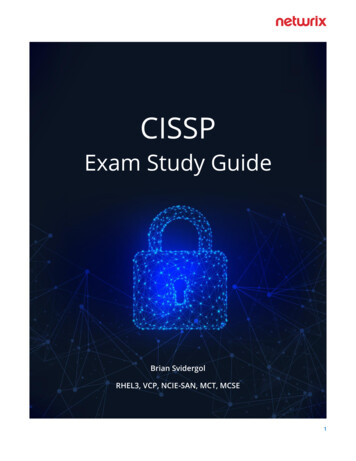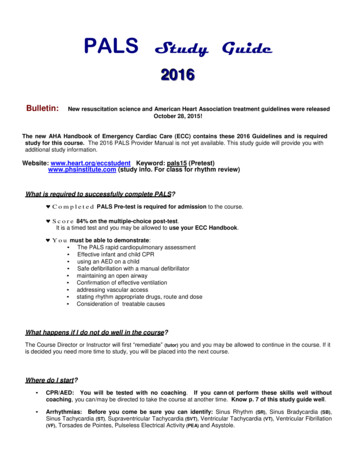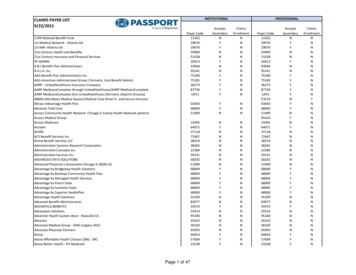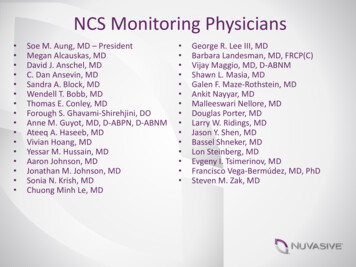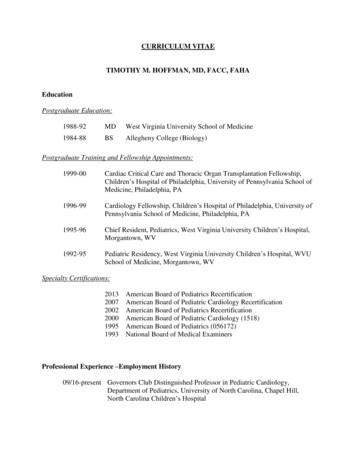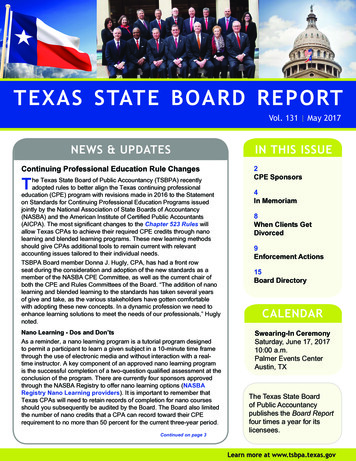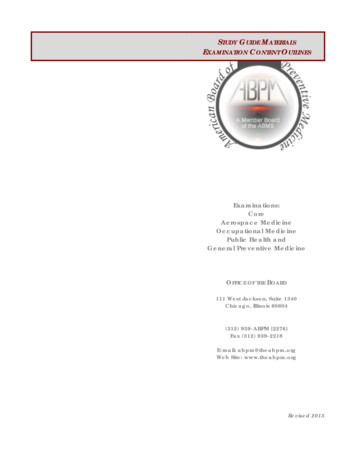
Transcription
STUDY GUIDE MATERIALSEXAMINATION CONTENT OUTLINESExaminations:CoreAerospace MedicineOccupational MedicinePublic Health andGeneral Preventive MedicineOFFICE OF THE BOARD111 West Jackson, Suite 1340Chicago, Illinois 60604(312) 939-ABPM [2276]Fax (312) 939-2218E-mail: abpm@theabpm.orgWeb Site: www.theabpm.orgRevised 2015
The specialty area examinations are intended to assess whetherthe candidate claiming to have the knowledge, skills, andexperience associated with comprehensive specialty practiceis qualified to do so. The Board recognizes that many applicantsare engaged in practice or have received training which is notfully congruent with Board expectations. However, the Boardcannot adjust its definition of specialty practice to conform tothe day-to-day work experience of a varied group ofapplicants. Applicants who judge their training and experienceto lack elements regarded by the Board as important will find ithelpful to prepare for comprehensive specialty practice, andexamination, by guided study. This Study Guide outlines thescope of practice and provides a list of useful texts andperiodicals. There is no certainty that the answer to everyexamination question will be found in the cited materials, asmany questions require an exercise of discernment andjudgment rather than a specific textbook answer.Introduction to The GuideThis Guide has been prepared for physicians who seek todevelop knowledge and skills in Preventive Medicinethrough appropriate reading, class work, formal training,and experience. The Guide describes the scope andcontent of the field, including the specialty areas, so thatphysicians may know what is expected of them as theyengage in comprehensive specialty practice or preparefor examination by the American Board of PreventiveMedicine (ABPM). In addition, a list of competencies hasbeen developed for Preventive Medicine practitioners.1,2Review of the competencies and the accompanyingperformance indicators will assist in targeting contentareas for study or review.A companion document prepared by the ABPM, entitledAnswers to Your Most Asked Questions, provides additionalinformation on the examination.Candidates commonly inquire if review books, courses, orsimilar exam preparation offerings are of value. Manyexaminees feel that brief courses enhance recall of previouslyacquired knowledge and improve one’s approach to multiplechoice examinations in general. But it is quite unlikely thatanyone will learn, for example, biostatistics or toxicology, in areview course or from a review CD or other media. Board andexam committee members do not participate as faculty in suchactivities nor are such practice questions abstracted fromBoard examinations and vice versa. Some review questionsmay be similar to examination questions; however it is notcorrect to infer that there is a transfer of content as a smallchange in a question or in a response may change what is thecorrect answer.The Guide includes outlines of core and specialty areacontent; approximate percentage distributions of testitems; lists of books, periodicals, and other materials whichhave been found to be useful to practitioners andexaminees; and general information about Boardexaminations. The outlines and lists are not claimed to beall-inclusive or definitive. In every specialty, time andcircumstances bring changes in what is expected of itspractitioners. Books grow out of date and are replaced bylater editions or alternative works by different authors.Thus, although the Guide is revised from time to time, theBoard makes no claim that cited texts are best or mostcurrent and cannot assure that persons who read any orall listed texts will achieve competence or perform atsome predictable level on the examination. Further, it iswell recognized that personal backgrounds andpreferences are important determinants of the suitabilityof any particular text or educational medium.There are no trick questions, and it would be unusual for aquestion to reflect very recent events or issues (i.e., new Ahot@topics) because of the lead time necessary to develop the fullexamination. The general purpose is to ascertain whether thereis a sound base of specialty-relevant knowledge and skills andthe ability to exercise discernment and judgment.There are 150 questions on the core and 150 questions on thespecialty area examinations. All questions are weightedequally. Candidates will find it of advantage to answer allquestions, and there is no penalty for an incorrect answer, i.e.,wrong answers are not subtracted from right answers and thereis no advantage in leaving a question unanswered. Thus, thecandidate who has no idea as to the correct answer andresponds at random will have a 25% chance of selecting itsince there are four choices for each questions. In most cases,even when the correct answer is not known with confidence,the candidate will have sufficient knowledge to exclude 2 or 3of the choices as improbable. Guessing on the remainingpossibilities offers better odds than 25% and reflects the factthat the candidate should earn partial advantage fromknowing what is not right.Examinations conducted by the ABPM are intended toconfirm the determination by the Board that thecandidate is qualified by training and experience to claimcompetence in the respective specialty area.Accordingly, the examinations cover both PreventiveMedicine core and the more focused content of specialtypractice. The former emphasizes the approach of thephysician to the prevention and control of disease inpopulations and the promotion of health. Fundamentalare biostatistical and epidemiologic skills; anunderstanding of the organizational and administrativefactors related to regulations, multi-disciplinary agencies,and the legal system; and basic comprehensivePreventive Medicine knowledge, including basicAerospace Medicine, Occupational Medicine, and PublicHealth and General Preventive Medicine.Board examination questions are all multiple choice, best singleanswer with four possible responses. The question may containa clinical vignette, an experimental or epidemiologicalobservation, a definition or classification, an administrativeproblem, an application of a principle or regulation, or anysituation which might be faced by a specialist in practice.(1) Lane D.S., Ross V., Parkinson M.D., Chen D.W.: PerformanceIndicators for Assessing Competencies of Preventive MedicineResidents, American Journal of Preventive Medicine, 1995; 11:1-8(2) Lane D.S., Ross V., Chen D.W., O Neill, C.: Core Competencies forPreventive Medicine Residents: Version 2.0, American Journal ofPreventive Medicine, 1999; 16:367-372.2
SAMPLE QUESTIONS1.STUDY OUTLINESThe effectiveness of a new blood test for thedetection of disease X was studied in a group of 100patients with disease X and a group of 400 healthypersons. The following data were obtained.Four outlines follow: 1) the overall specialty of PreventiveMedicine (referred to in examinations as Core); 2) AerospaceMedicine; 3) Occupational Medicine; and 4) Public Health andGeneral Preventive Medicine. Each outline is intended todescribe the scope of the field; the scope of the respectiveexamination is essentially congruent. However the statement ofscope does not reflect the appropriate weighting of any givenitem as determined by importance or frequency in practice.Thus, items of fundamental importance and those with lessfrequent application or more peripheral concern appear inoutline to be equivalent.DiseasePresentTest PositiveTest NegativeTotalAbsentTotal99301291370371100400500The distribution of examination questions is weighted in favor ofrelevance to actual practice; however candidates who arepreparing to represent themselves as medical specialists mustrecognize that they are responsible for knowledge and skillsacross the breadth of their chosen specialty field, not only in thepreponderant content of their day-to-day practice.Examinations do not stress esoterica, and they do require thatexaminees demonstrate sound understanding of the entirespecialty. A primary purpose of these outlines is to describe theextent of the specialty fields.The specificity of the test is best expressed as:A.B.C.D.2. 7.5%76.7%92.5%99.0%An additional statement about the Core is appropriate. TheCore examination is intended to cover material which isexpected to be understood by all specialists in PreventiveMedicine. All diplomates of the Board are expected to share acommon or core competence in biostatistics, epidemiology,occupational and environmental health, clinical preventivemedicine, and administration. The Core questions assess thecandidate s grasp of fundamentals required of all physicians inPreventive Medicine.alpha radiationbeta radiationgamma radiationneutron radiationWhich of the following disorders is responsible for thegreatest loss of disability-adjusted life-years (DALYs)?A.B.C.D.4.x 100%x 100%x 100%x 100%The increased incidence of lung cancer amonguranium miners is best attributed to exposure ar diseaseDepressive disordersDiabetes mellitusSchizophreniaAn underserved rural area has a relatively highnumber of HIV infection / AIDS patients who areuninsured. What federal agency may be a potentialsource of funding to provide care for them?A.Health Resources and Services Administration(HRSA)B. Agency for Healthcare Research and Quality(AHRQ)C. National Institutes of Health (NIH)D. Centers for Disease Control and Prevention(CDC)3
PREVENTIVE MEDICINE CORECORE OUTLINEBOOKSHeymann, D.L. (Ed.): Control of Communicable DiseasesManual, 19th Ed., American Public Health Assn, 2008.Jekel, James F., et al: Epidemiology, Biostatistics andPreventive Medicine, 3rd Ed., W.B. SaundersCompany, Philadelphia, 2007.Last, J.M., Wallace, R.: Maxcy-Rosenau-Last, Public Healthand Preventive Medicine, 15th Ed., McGraw Hill, 2007.I.HEALTH SERVICES MANAGEMENT (SYSTEMS-BASED PRACTICE)A. Organization1. Government2. Service DeliveryB. Health Care Delivery1. Models2. Medical Management3. Business Management4. Utilization ManagementC. Finance and Economics1. Health Care Economics2. Services Payment and Financing3. Financial ManagementD. Organizational Structure and Development1. Bureaucracy Characteristics2. Strategic Planning and Policy Development3. Program Assessment and Evaluation4. Quality and Patient Safety5. Organizational Development/EffectivenessE. Legal and Ethical Issues1. Ethics2. Legislation and Regulatory ComplianceII.EPIDEMIOLOGY AND BIOSTATISTICSA. Design and Methods1. Data Sources and Coding2. Study Design3. Biases and Control Measures4. Confounding5. Decision AnalysisB. Interpretation1. Measures of Central Tendency2. Tests of Significance3. Probablility4. Hypothesis Testing5. Type I error6. Type II error7. Confidence intervals8. Power9. Sample Size10. Multivariate analysis11. Correlation12. Multiple regression13. Survival Analysis14. Meta-Analysis15. Number Needed to Treat16. Causation and Association17. Measurement of EffectC. Vital Statistics and Demography1. Rates and Measures2. TrendsD. Prevention and Control1. Disease Surveillance-Active and Passive2. Screening Tests3. Outbreak Investigation and InterventionWEBSITESU.S. Preventive Services Task Force: Guide to ClinicalPreventive Services. http://www.ahrq.govMedical Guidelines for Airline Travel, 2nd fMorbidity Mortality Weekly Reports;http://www.cdc.gov/mmwr/PERIODICALS (PREVIOUS FIVE YEARS) INCLUDING:American Journal of Preventive Medicine.STUDY QUESTIONSHebel JR and McCarter RJ: A Study Guide toEpidemiology and Biostatistics, 7th Ed., Jones andBartlett, Sudbury, MA, 2012.Katz, David L.: Epidemiology Biostatistics and PreventiveMedicine Review, 3rd Ed., W.B. Saunders Company,Philadelphia, 2007.Ratelle, S.: Preventive Medicine and Public Health, Pre-TestSelf-Assessment and Review, 9th Ed., McGraw-Hill,New York, 2000.PERCENTAGE DISTRIBUTION OF TEST ITEMSI.Health Services Management (Systems-BasedPractice) 15%II. Epidemiology and Biostatistics 35%III. Clinical Preventive Medicine 20%IV. Behavior and Mental Health 12%V. Environmental 18%4
III. CLINICAL PREVENTIVE MEDICINEA. Cardiovascular Diseases1. Coronary Artery Disease2. Cerebrovascular Disease3. Hypertension4. HyperlipidemiaB. Respiratory Diseases1. Asthma2. COPD3. OtherC. Neoplastic Diseases1. Bladder Cancer2. Breast Cancer3. Cervical Cancer4. Gastrointestinal Cancers5. Hematological Malignancies6. Lung Cancer7. Oral Cancer8. Ovarian Cancer9. Prostate Cancer10. Skin Cancer11. Testicular Cancer12. Thyroid CancerD. Infectious Diseases1. Bacterial2. Viral3. Parasitic4. Fungal5. Spirochete6. Atypical7. Food-borne Illnesses8. Sexually Transmitted9. Immunizations10. Emerging InfectionsE. Metabolic Disorders and Nutrition1. Diabetes Mellitus2. Thyroid Diseases3. Obesity4. Clinical NutritionF. Musculoskeletal Disorders1. Osteoporosis2. Back Pain & Sciatica3. ArthritisG. Neurological DisordersH. Oral Health, Vision and Hearing Disorders1. Oral Health2. Visual Disorders3. Hearing ImpairmentI.Maternal & Child HealthJ. GeneticsK. Complementary and Alternative CareC.1.2.3.V.IV. BEHAVIOR AND MENTAL HEALTHA. Mental/Behavioral Disorders1. Epidemiology2. Prevention/Intervention3. Risk FactorsB. Substance Abuse1. Epidemiology2. Risk Factors3. Screening4. Prevention/Intervention5Health Promotion and Health ScreeningHealth Education Theories and ModelsIndividualPopulationENVIRONMENTALA. Agents1. Chemical2. Physical3. BiologicalB. Community health1. Air quality2. Water quality3. Climate4. Food safety5. Sanitation6. Hazardous materials management7. Radiation8. Heat/cold9. Noise10. InjuryC. Occupational medicineD. Aerospace medicineE. TravelF. Risk AssessmentG. Risk ManagementH. Risk CommunicationI.Disaster planning and management1. Natural2. Manmade/Bioterrorism
G. Human factors1. Human-machine interface2. Human performanceH. Aerospace systems1. Vehicles2. Ground support3. Simulators4. Remotely Piloted Vehicles5. Escape mechanisms6. Medical systemsAEROSPACE MEDICINEBOOKSDavis, J.R, et al.: Fundamentals of Aerospace Medicine, 4thEd., Lippincott Williams & Wilkins, 2008.Gradwell, D.P, Rainford, D.J.: Ernsting's Aviation and SpaceMedicine, 5th Ed., CRC Press, Boca Raton, FL, 2016.Barratt, M.R., et al.: Principles of Clinical Medicine for SpaceFlight, 1st ed, Springer, 2008.Rayman, R.B., et al.: Rayman's Clinical Aviation Medicine,5th Ed., Castle Connolly Graduate Medical Publishing,New York, 2013.II.WEBSITESAerospace Medical Association Medical Guidelines forAirline sfor-airline-travelASAMS Aerospace Medicine Practice Guidelineshttp://www.asams.org/guidelines.htmGuide for Aviation Medical Examinershttp://www.faa.gov/about/office org/headquarters II. OPERATIONAL AEROSPACE MEDICINEA. Air and space operations1. Military2. Civil aviation3. SpaceB. Selection and retention1. Medical standards2. Aeromedical evaluations3. Longitudinal surveillanceC. Aeromedical transportationD. Survival, search and rescue1. Crash worthiness2. Search and rescue systems3. Airport disaster managementE. Mishap investigation1. Site activities2. Forensic considerations3. Accident rate and dataF. Travel medicinePERIODICALS (PREVIOUS FIVE YEARS) INCLUDING:Aviation, Space and Environmental MedicinePERCENTAGE DISTRIBUTION OF TEST ITEMSI.II.III.IV.The Flight Environment (40%)Clinical Aerospace Medicine (30%)Operational Aerospace Medicine (20%)Management and Administration (10%)SPECIALTY OUTLINEI.CLINICAL AEROSPACE MEDICINEA. Fitness for duty and return to work1. Cardiology2. Pulmonary3. Ophthalmology4. Otolaryngology5. Psychology and psychiatry6. Neurology7. Other medical and surgical conditionsB. Health maintenance1. Wellness2. Self-imposed stressTHE FLIGHT ENVIRONMENTA. The BiosphereB. Theory of flight1. Aviation - fixed and rotary wing2. SpaceflightC. Physiology1. Respiratory2. Cardiovascular3. Spatial orientation4. Bioacoustics5. VisualD. Gravitational effects1. High performance2. MicrogravityE. Pressure effects1. Hypobaric2. HyperbaricF. Other physical effects1. Shock and vibration2. Thermal3. Radiation4. ToxicologyIV. MANAGEMENT AND ADMINISTRATIONA. Regulations1. Military2. Civil3. InternationalB. Organizations1. ICAO2. WHO3. DOT/FAA4. NASA5. NTSB6
5. Temperature6. Mechanical & electrmagnetic7. Vibration8. LasersE. Chronobiology1. Fatigue2. Shift work3. TravelF. Occupational safety and controlsG. Industrial hygiene1. Engineering Controls2. Personal protective equipment3. Administrative ControlsH. Environmental HealthI.Risk AssessmentOCCUPATIONAL MEDICINEBOOKSLaDou, J.: Current Occupational & Environmental Medicine,4th Ed., McGraw Hill Companies, New York, 2007.Rom, W.N. & Markowitz S: Environmental and OccupationalMedicine, 4th Ed., Lippincott Williams & Wilkins, 2006.Guidotti, T.L.: Occupational Health Services: A PracticalApproach, 2nd Ed., Routledge, 2012.ACOEM Occupational Medicine Practice Guidelines, 3rd Ed.,2011.Re: ACOEM Guidelines, focus on: Foundations ofOccupational Medicine, core concepts of diagnosis,management and treatment of conditions, summarytables and recommendations for each disorder.II.WEBSITESAgency for Toxic Substances and Disease Registryhttp://www.atsdr.cdc.govAmerican College of Occupational and EnvironmentalMedicine Competencieshttp://www.acoem.org/oem.aspxNational Institute of Occupational Safety and Healthhttp://www.cdc.gov/nioshOccupational Safety and Health Administrationhttp://www.osha.govPERIODICALS INCLUDING:Journal of Occupational and Environmental MedicinePERCENTAGE DISTRIBUTION OF TEST ITEMSI.Prevention, Exposure Assessment, Hazard Recognition andControl (20%)II. Clinical Patient Care (60%)III. OEHS Administration and Systems-basedPractice (20%)SPECIALTY OUTLINEI.PREVENTION, EXPOSURE ASSESSMENT, HAZARD RECOGNITION ANDCONTROLA. Hazard Characterization1. Walk through assessment2. Industrial hygiene surveysB. Toxicological Principles1. Toxicokinetics2. Carcinogenesis3. Hydrocarbons & solvents4. Metals5. Gases6. Dusts7. Pesticides8. Nitrogen Compounds9. Chemical Warfare agentsC. Ergonomics1. Evaluation2. ControlD. Physical Hazards1. Ionizing radiation2. Non-ionizing radiation3. Noise4. Dysbarism7CLINICAL PATIENT CAREA. General Patient Evaluation and Testing1. Exposure & occupational history2. Causation & Work-relatedness3. Contributing factorsB. Eyes1. Screening2. InjuryC. Ear, Nose and Throat1. Noise & solvent induced Hearing Loss2. Acute Acoustic Trauma3. Assessment:a. Audiometry4. BarotraumaD. Pulmonary1. Occupational Diseasea. Pneumoconiosisb. Asthmac. Allergic and Immunologic Diseased. Inhalation Disorderse. Cancer2. Pulmonary Function Testing3. Respirator Certification4. PreventionE. Heart & vascular System1. Effects of physical & chemical agents2. Physically and psychologically stressful duties3. Fitness for dutyF. Hepatic and gastrointestinal1. Liver & biliary tract disorders2. Cancer3. Liver function testingG. Genitourinary1. Renal disorders2. Renal & Bladder CancerH. Hematology/Oncology1. Hematologic Disorders2. Hematologic Cancers3. Clinical & Laboratory studiesa. Medical surveillanceb. Post-exposureI.Infectious Diseases and Biohazards1. Blood borne pathogens2. Tuberculosis3. Diseases of travelers & workers4. Zoonotic disease5. Building-related illnesses6. Biologic warfare
J.Musculoskeletal1. Spine Disorders & Back Paina. Diagnosis & managementb. Treatment & Prevention2. Upper Extremity Disordersa. Entrapment Neuropathiesb. Overuse syndromes3. Joint and Extremity injuries & disordersK. Neurologic disorders1. Neurological & mental status exams2. Neurotoxic exposures3. Central Nervous System Disorders4. Peripheral Neuropathy5. Interpretation of neurologic testing6. Sleep disordersL. Mental Disorders1. Effects on work capacity2. Identify, manage & refer impaired employee3. Work place stressM. Reproductive Disorders1. Common reproductive toxins and their effects2. Risk & Exposure3. Protection of fertilityN. Dermatology1. Allergic & irritant dermatitis2. Urticaria3. Infections4. Neoplasia5. Pigmentation disorders6. Work-aggravated dermatosesO. Clinical Toxicology1. Evaluate & treat exposure to toxinsP. Pain Management1. Acute & Chronic managementK.L.III. OEHS ADMINISTRATION AND SYSTEMS-BASED PRACTICEA. Surveillance1. Principles of surveillance2. Occupational Disease Surveillance3. Medical surveillance programs in the workplaceB. Medical ethics and confidentialityC. Regulations1. OSHA2. EPA3. ADA and ADAAA4. GINA5. FMLAD. Workers' compensation1. Payment principles2. Disability assessmentE. Health care delivery systemsF. OEHS program managementG. Health and productivity1. Health Risk assessments2.Nutrition3. Physical activity4. Lifestyle MedicineH. Emergency and disaster management1. Programmatic planning2. Chemical3. Biological4. NuclearI.Transportation medicine1. Commercial Driver Medical ExaminationsJ. Disability administration81. Disability prevention and management2. Americans with Disabilities Act3. Fitness for Duty and Return to WorkSubstance use and abuse1. Employee Assistance ProgramsWorkplace violence
II.PUBLIC HEALTH AND GENERAL PREVENTIVE MEDICINEBOOKSFriis, R.H.: Essentials of Environmental Health, 2nd ed, Jones andBartlett, 2012.Haynes, R.B., et al: Clinical Epidemiology: How to Do ClinicalPractice Research, 3rd Ed., Lippincott Williams & Wilkins,2005.Novick L.F., et al: Public Health Administration: Principles forPopulation-Based Management, 2nd Ed, Jones & Bartlett,2007.Rothman, K.J., et al: Modern Epidemiology, 3rd ed, LippincottWilliams & Wilkins, 2008.Scutchfield F.D., Keck C.W.: Principles of Public Health Practice,3rd ed, Delmar, 2009.WEBSITESGuide to Community Preventive Serviceshttp://thecommunityguide.orgHealthy People 2020http://www.healthypeople.govIII. BIOSTATISTICSA. Describing data1. Frequencies and distributions2. Measures of central tendency3. Measures of variation4. Probability5. Standard scores6. P-valuesB. Statistics1. Statistical inference2. t test3. Analysis of variance (ANOVA)4. Simple linear regression5. Multiple regression6. Analysis of covariance7. Time series analysis8. Chi-square9. Measurement scales10. Binomial test11. Fisher exact test12. McNemar test13. Mann-Whitney test14. Median test15. Sign test16. Wilcoxon test17. Spearman Rank Correlation Coefficient18. Life table (or survival) analysis19. Logistic regression20. Multivariable analysis of variance21. Multiple correlation coefficient22. Partial correlationC. Hypothesis testingD. Meta-analysis*In addition to the reference material listed above, allreference materials (books, periodicals, and study questions)listed for the Core on page 4 are applicable.PERCENTAGE DISTRIBUTION OF TEST ITEMSI.II.III.IV.V.HEALTH SERVICES ADMINISTRATION (30%)ENVIRONMENTAL HEALTH (15%)BIOSTATISTICS (10%)EPIDEMIOLOGY (15%)CLINICAL PREVENTIVE MEDICINE (30%)SPECIALTY OUTLINEI.ENVIRONMENTAL HEALTHA. Global issues1. Climate change2. Threat of nuclear warfare3. Biological warfare and bioterrorism4. Chemical warfare and terrorismB. Public health protection1. Air quality2. Water quality3. Food quality4. Physical stressors5. Solid waste management6. Hazardous materials management7. Land use and planning8. Environmental site assessmentC. Risk assessment1. Hazard identification2. Exposure assessment3. Dose response assessment4. Risk characterizationHEALTH SERVICES ADMINISTRATION ANDSYSTEMS-BASED PRACTICEA. Organization1. Public sector2. Private sectorB. Financing and delivery1. Public sector2. Private sector3. Financing mechanismsC. Public health practice1. Concepts, definitions and practice areas2. Legal and ethical issues3. Public health practice toolsD. Systems-based practice1. Medical errors and patient safety2. Quality measurement, assurance andimprovement3. Patient satisfaction and functional status4. Demand and disease management strategiesand programs9
IV. EPIDEMIOLOGYA. Data sources1. Vital records2. Reportable diseases3. Surveys4. Registries5. Morbidity6. Census7. National health surveysB. Study design1. Experimental studies2. Quasi-experimental studies3. Observational studiesC. Measurements of morbidity and mortality1. Rates, ratios and proportions2. Life expectancy3. Population pyramids4. Measures of disabilityD. Measures of effect1. Attributable risk (risk difference)2. Relative risk3. Odds ratioE. Epidemiologic associations and datainterpretation1. Causality2. Bias (systematic error)3. GeneralizabilityF. Epidemiology of infectious diseases1. Agents2. Characteristics of infectious agents3. Host characteristics4. Environment characteristics5. Modes of transmission6. Measures of disease outbreaks7. Outbreak investigation and intervention8. Evaluation of interventionG. Legal and ethical aspects of epidemiologicstudies1. Human subjects review2. Screening3. Conflicts of interest4. Community involvement5. Archived samplesV.11. Prenatal screening12. Pediatric health supervision/anticipatoryguidance13. Genetic screeningC. Tertiary prevention and disease management1. Antibiotic resistant organisms2. Organ transplantationCLINICAL PREVENTIVE MEDICINEA. Primary prevention1. Personal health behaviors2. Infectious diseases3. ChemoprophylaxisB. Secondary prevention1. Principles of screening2. Cardiovascular disease3. Cancer4. Infectious diseases5. Metabolic disorders6. Hematologic disorders7. Respiratory disorders8. Ophthalmologic and otologic disorders9. Mental disorders10. Musculoskeletal disorders10
Ratelle, S.: Preventive Medicine and Public Health, PreTest - Self-Assessment and Review, 9th Ed., McGraw-Hill, New York, 2000. PERCENTAGE DISTRIBUTION OF TEST ITEMS . I. Health Services Management (Systems-Based Practice) 15% . II. Epidemiology and Biostatistics 35% . III. Clinical Preventive Medic






